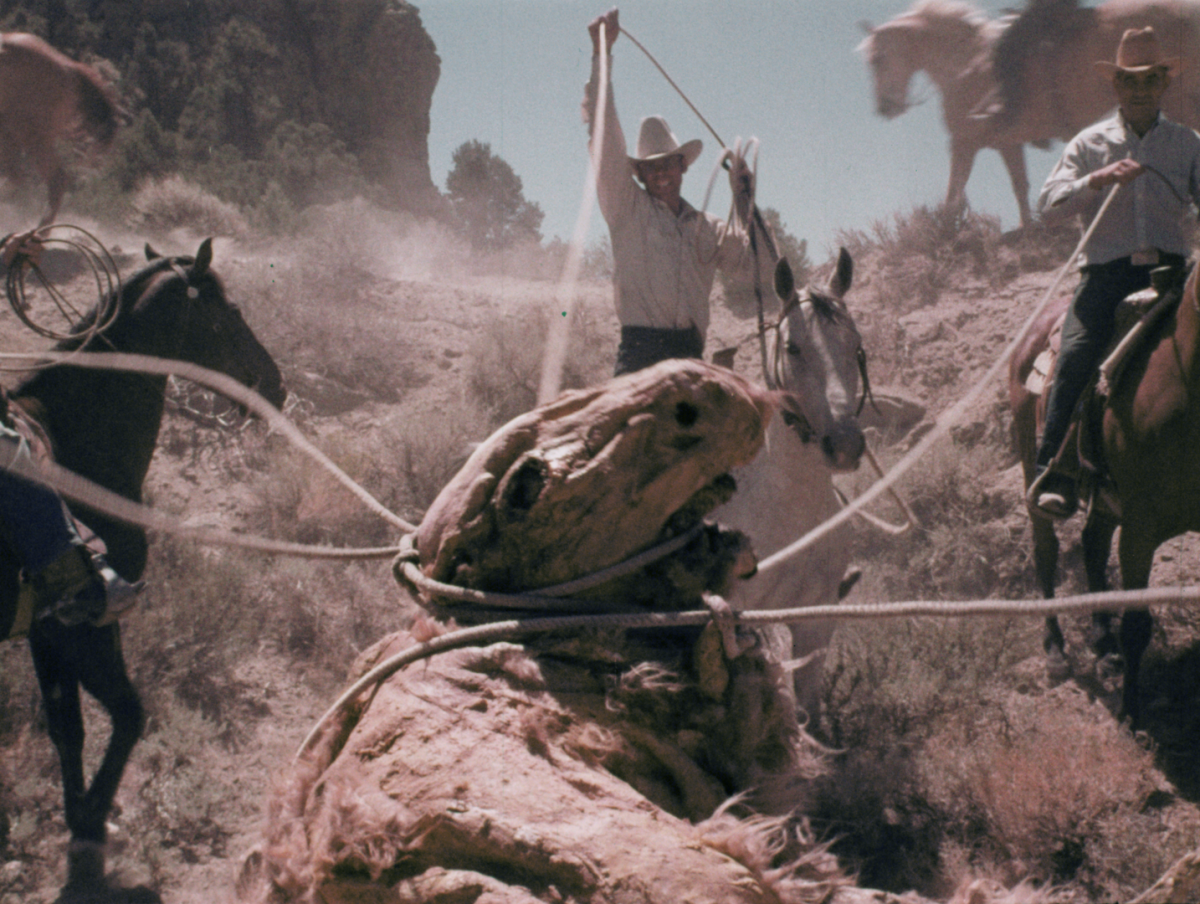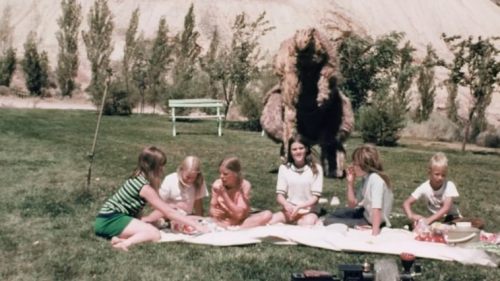Fredric Hobbs And The Cult Afterlife Of GODMONSTER OF INDIAN FLATS
“Sure can tell a lot about folks by the stuff they throw into the garbage.” – Garbage Mike, Godmonster of Indian Flats
If the collection of films the American movie industry has tossed aside as rubbish were an indicator of character, American movie culture would seem somewhat cruel and elitist. Thankfully, due to the passion and hard work of cinematic dumpster divers such as Something Weird Video and the American Genre Film Archive (AGFA), movies that could have very easily and regrettably been lost to time have not only proliferated, but are now making the leap to high-definition. Many of these are from outsiders, weirdos and underground artists whose mere existence hints at secret corners of American movie history. They represent perspectives and styles totally unique to their filmographies (which rarely contain more than a fistful of films). Sometimes these movies also have giant mutant sheep monsters.

Such is the case with Bay Area artist Fredric Hobbs’ fourth and final feature, Godmonster of Indian Flats (check out the AGFA trailer here), making its HD debut this month on Blu-ray from AGFA and Something Weird. Hobbs is perhaps the least likely filmmaker to find his way onto cult movie shelves neighboring Herschell Gordon Lewis, Doris Wishman, and Ed Wood. Prior to making his first feature in 1969, Hobbs was a fine artist who, in addition to working in traditional painting and sculpture, began inventing wild, new forms of art such as his “parade sculptures”: cars modified with layers of organic sculpture he drove across the U.S. These rolling roadshows contained names such as “Sun Chariot” and “Trojan Horse” (the latter of which can be seen in Hobbs’ film Alabama's Ghost). Hobbs wanted to take art out of the museum and meet people where they were. One of those places was the movies.
Reviews for Hobbs’ first film Troika can be found online and Stephen Thrower writes a very detailed description of it in his seminal book on American independent horror Nightmare USA, but unfortunately, at this time there is no way to view the film itself.
Roseland (1971) enjoyed a wider theatrical release courtesy of Harry Novak’s Box Office International and a second life as an early Something Weird Video VHS release. While devoid of the more fantastic elements that make Alabama's Ghost and Godmonster so fun, it’s still an indicator of Hobbs’ difficult-to-define sensibilities: a mixture of mainstream influence (shades of popular rock musicals here) with satire and arch humor, often directed simultaneously at counterculture and powerful American institutions. It also contains the musical number “You Cannot Fart Around With Love.”
Alabama's Ghost (1973) found an unlikely home on VHS a decade after its limited theatrical release with wraparound host segments from Elvira. Rarely has the horror host struggled so much as she attempts to riff on this inscrutable cautionary tale about the dangers of messing around with magic. A summary of the plot does no justice to the experience of watching this acid-damaged pulp adventure unfold, but viewers unfamiliar with it should go in expecting 1920s magic acts, jazz slang, a racist ghost, a counterculture rock star magician, voodoo, purple-faced vampires, a Nazi multimedia mogul and a lot of to-do about a vanishing elephant. It goes without saying that 1973 audiences had no idea what to make of such a pungent cocktail, and attempts to market it as a blaxploitation movie (on nothing but the fact that it stars a black actor) went over about as well as one would expect.
Before audiences had a chance to reject Alabama, Hobbs was already in production on what would sadly be his final feature. Godmonster of Indian Flats has all of the hallmarks of atomic age schlock: a low budget, a mutant monster, mumbo-jumbo sci-fi nonsense, and a cast of underacting non-actors and overacting stage actors. This movie should be unremarkable. Instead it’s a genuine curiosity from a singular artist that’s as fun as it is baffling. Imagine a collaboration between David Lynch and Joe Dante, and you might get close to the heart of this movie.

Godmonster is bifurcated by a plot about a scientist researching a mysterious sheep embryo and a plot about a conservative landowner resisting buyout from a corporate prospector. Lingering on the details too long could cause one’s brain to swell, but suffice to say these two plots run parallel on separate tracks until they crash together beautifully in the film’s climax. As one of the characters articulates so well, “Events have a certain logic. A way of falling down the mountains like an avalanche.” It reminds one of the legend that French authors Pierre Souvestre and Marcel Allain wrote their Fantomas novels by coming up with a rough outline together then writing alternating chapters in isolation, giving the novels a loose, disjointed, unreal feeling that delighted the Surrealists. Godmonster is like that if there were no outline to begin with.
Hobbs didn’t believe in rewrites. His filmmaking, not unlike David Lynch, is driven by intuition, along with an obsession for capturing images that communicate abstract ideas. The comparisons to Lynch are numerous: both began as artists and both share a knack for exploring spiritual and moral rot beneath the surface of Americana. An avid environmentalist, Hobbs had a particular affinity for the history of Virginia City, Nevada: the setting of Godmonster and subject of a book he co-wrote in 1978. Once the richest city in the U.S. thanks to massive gold and silver finds, Virginia City represents the ultimate exploitation of the earth by industry in the pursuit of greed. When the mines went dry, it also represented the fleeting nature of material riches. Contemporary Virginia City is a tourist destination with its preserved 19th century facades and retro Bonanza parades. It was the perfect setting for a low-budget movie.
Godmonster of Indian Flats presents a burlesque version of Virginia City. Presided over by Mayor Charles Silverdale, the town is full of corrupt, thieving citizens and kept in line by a fascist sheriff who has more surveillance equipment than scruples. “Walking around like he’s the head of the FBI or something,” as a character puts it. For anyone who thinks Hobbs wasn’t having fun with his ridiculous characters, watch as the sheriff’s outfits change, how he continues to keep his badge on display. What a pro.
Then there’s that un-ignorable credit in the opening: “Monster design by Fredric Hobbs.” And what a monster! Hobbs’ sculpture is a grotesque mass of wool, bone, and gnarled flesh, one markedly longer front limb dangling as the poor beast hobbles towards its victims on its hind legs. It’s the kind of thing that could inspire laughter as easily as nightmares. An indescribable phantasm which a Lovecraft protagonist would encounter shortly before going mad, but rendered for a Bert I. Gordon production. That is all to say it’s the kind of movie monster that has brought us joy for decades. Just don’t invite it to your next picnic.

These disparate pieces weave together as the story unfolds. Delicious conflict arises as an egomaniacal anthropology professor keeps his discovery of a quickly mutating sheep embryo secret, and the greedy mayor orchestrates a phony dog funeral as pretext to harassing the visiting land prospector (don’t worry, in context it kind of makes sense). Whether the mutant sheep is a mythical godmonster sent to Earth in order to punish mankind for pillaging the land -- or whether it’s just a “typical” mutant sheep created by gases escaping from mine shafts -- is a secret the movie won’t reveal.
One can imagine how easily dismissible this movie must have seemed in 1973, all of its quirks and idiosyncrasies overshadowed by its superficial flaws. That we have the ability to view this movie at all in 2018 is a miracle, thanks in no small part to fans Mike Vraney and Lisa Petrucci who distributed the movie on DVD through Something Weird. Godmonster’s bizarre affectations can now be appreciated by a whole new generation of cult film aficionados as AGFA is set to distribute a new scan of the only known theatrical print, both on Blu-ray and as a DCP available to theaters across the country and the world. Hobbs passed away in April of this year, and as he indicated in “Nightmare USA,” he always felt disappointed that Godmonster never got the appreciation it deserved. Hopefully its continued life, rediscovery and reevaluation offer him posthumous redemption.
When the venal Mayor Silverdale all but shouts “Make Virginia City Great Again!”, a protestor responds “you haven’t restored the past, you’ve destroyed the present!” Chillingly relevant words for a movie that also features a 10-foot-tall sheep monster. Thankfully, in restoring Godmonster of Indian Flats, AGFA has both restored the past and enriched the present. Long live the godmonster!



_500_281_81_s_c1.jpg)